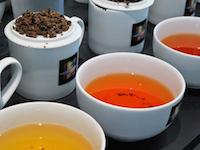 So there we were, a group of 40 passionate food professionals, writers and bloggers noisily slurping tea from our spoons at a Dilmah Tea Masterclass at AUT in Auckland. We had just been taught that the best way to taste tea is to slurp it as this allows the taste buds to become fully involved.
So there we were, a group of 40 passionate food professionals, writers and bloggers noisily slurping tea from our spoons at a Dilmah Tea Masterclass at AUT in Auckland. We had just been taught that the best way to taste tea is to slurp it as this allows the taste buds to become fully involved.
Four loose-leaf teas (white, oolong, green and black) were presented in white porcelain bowls for the tasting. They ranged in colour from a very pale brown to mahogany.
Interestingly all had come from the same tea plant,Camellia sinensis. The variation in colour was due to the fact that each had been dried and processed in different ways.
Terroir (the natural environment in which the tea is cultivated) also plays a significant role in the variations, taste, quality, character and appearance of tea. For example, if eucalyptus or wild mint is planted close by, the tea plant will absorb its flavour. On one plantation there may be as many as twenty terroirs, each with its own microclimate. This means that many kinds of tea can be produced from one plantation
Dilhan Fernando (Mr Dilmah’s son) expertly led us through tea’s fascinating history, culture and gastronomy. Tea was used as a medicine before it became a beverage, but things have come full circle – scientific research has confirmed that tea has health benefits, with both black and green tea containing powerful natural antioxidants.
Many people don’t know how to brew a really good cup of tea. “The most common problem is that everyone thinks they know,” said Dilhan. But in his travels around the world he frequently sees the best establishments getting it wrong.
The process may be simple, but when asked to prepare a cup of tea for a tasting by one of the world’s tea experts, I still felt a little daunted.
To make a cup of Dilmah black tea, I followed instructions and poured 220 ml of freshly boiled water over a heaped teaspoonful of loose-leaf tea, stirred, let it brew for 2 minutes and then stirred again. After another minute (so three minutes in all) the tealeaves were strained out and it was ready to drink.
Dilhan dipped his spoon into my tea bowl and slurped.
“I think maybe it’s a little too strong,” I murmured anxiously. But he assured me it tasted good.
Tea gastronomy is a new and rising culinary wave. It is Dilhan’s passion. We tasted some exciting and delicious tea and food pairings, both savoury and sweet, in which tea was used both as a drink and as part of a dish.
Here was a whole new world to explore, as there are so many different Dilmah teas and flavours to choose from. As a food blogger my head started to buzz with ideas of the many ways I could use tea to add flavour and texture to a marinade, rub, sauce, or pastry dough. Not to mention mocktails and cocktails!
At the end of the session Mr Dilmah, now in his eighties, made an appearance and touched all our hearts as he made an impassioned speech in which he looked back on his life. He shared with us that what he values most is not the success of the Dilmah business but that, through the Dilmah MJF Charitable Foundation he has been able to support thousands of underprivileged people in Sri Lanka and to also give to environmental projects. He dearly wishes that other businesses would follow Dilmah’s philosophy that “Business is a matter of Human Service.”
I felt very honoured, when we were awarded our certificates, to have the opportunity to shake hands with this remarkable man.
As soon as I got home I couldn’t wait to practice my perfect tea making skills on my partner. I brewed him a cup of gumboot tea, religiously remembering to stir the tea twice and brew for 3 minutes.
“Hmm, I can notice a difference,” he admitted appreciatively.
In winter nothing can beat a hot (and slightly boozy) toddy and scones straight out of the oven so next on my list to try out are these two great recipes from Dilmah:
Dilmah Gourmet Earl Grey Hot Toddy Tea Comforter
Ingredients:
1 Dilmah Gourmet Earl Grey Teabag
20 ml of whiskey
2 tbs honey
2 cloves
1 strip of orange rind
Method:
Place the whiskey, honey, cloves and orange rind in a mug with the Dilmah Gourmet Earl Grey Teabag.
Pour over hot water and brew for 5 minute
Take the tea bag and cloves out and make sure that the honey is dissolved and the whiskey is mixed through.
Perfect in winter with a batch of warm scones,
Rose & French Vanilla Scones
Ingredients:
3 cups self-raising flour, sifted
¼ cup castor sugar
1 cup cream
1 cup lemonade
2 tbsp Dilmah Exceptional Rose with French Vanilla tea
Pre-heat oven to 220°C. Lightly grease a baking tray.
Place flour and sugar in a large bowl.
Add cream, lemonade and Rose with French Vanilla Dilmah tea and mix to form a soft dough.
Turn onto a lightly floured workbench and knead lightly until combined.
Press the dough with your hands to a thickness of about 2cm.
Using a 6cm round cutter to cut out the scones, place in a baking tray and brush the tops with some milk.
Bake for approx 10-15 min until lightly browned.
Serve warm with your favourite jam and cream infused with Dilmah Exceptional Rose with French Vanilla Dilmah tea.
Preparation of cream for scones
Whip the cream and place ½ tsp of Dilmah Exceptional Rose with French Vanilla tea into the cream so that it is infused with its scent.









Join the Discussion
Type out your comment here:
You must be logged in to post a comment.